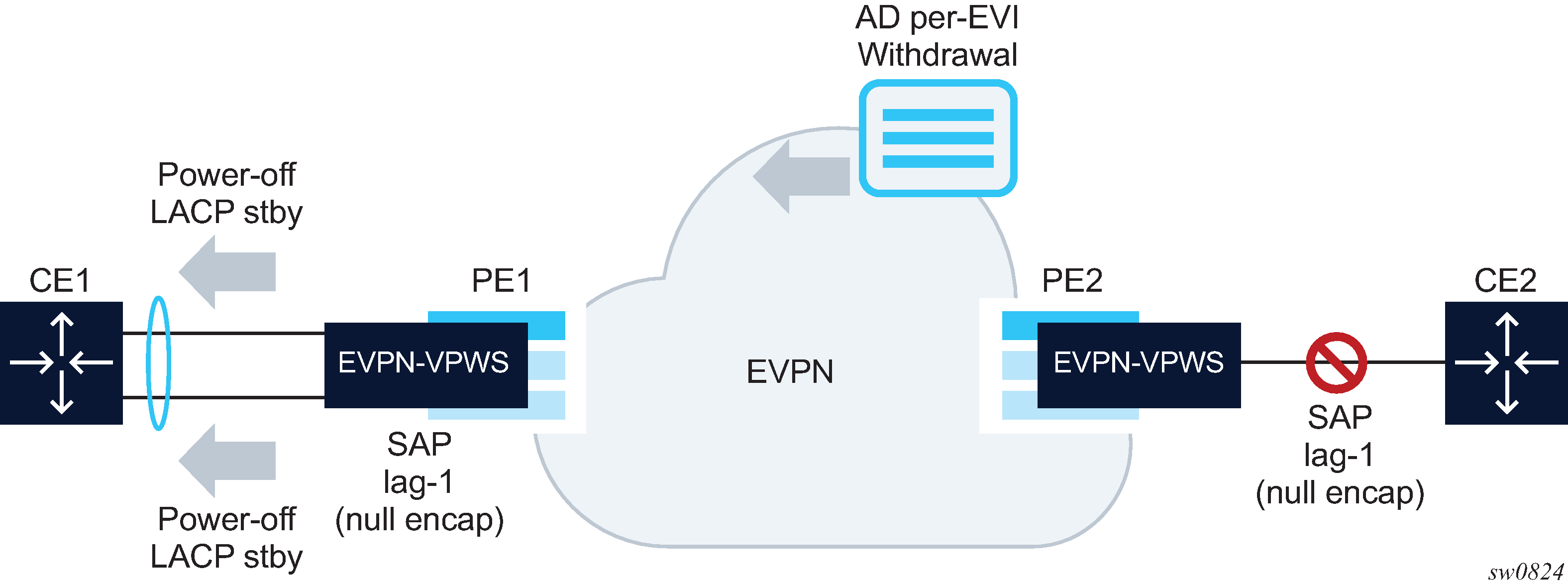SR OS uses Eth-CFM fault-propagation to support CE-to-CE fault propagation in EVPN-VPWS services. That is, upon detecting a CE failure, an EVPN-VPWS PE withdraws the corresponding Auto-Discovery per-EVI route, which then triggers a down MEP on the remote PE that signals the fault to the connected CE. In cases where the CE connected to EVPN-VPWS services does not support Eth-CFM, the fault can be propagated to the remote CE by using LAG standby-signaling, which can be LACP-based or simply power-off.
Figure 1 shows an example of link loss forwarding for EVPN-VPWS.

In this example, PE1 is configured as follows:
A:PE1>config>lag(1)# info
----------------------------------------------
mode access
encap-type null
port 1/1/1
port 1/1/2
standby-signaling power-off
monitor-oper-group "llf-1"
no shutdown
----------------------------------------------
*A:PE1>config>service>epipe# info
----------------------------------------------
bgp
exit
bgp-evpn
evi 1
local-attachment-circuit ac-1
eth-tag 1
exit
remote-attachment-circuit ac-2
eth-tag 2
exit
mpls bgp 1
oper-group "llf-1"
auto-bind-tunnel
resolution any
exit
no shutdown
exit
sap lag-1 create
no shutdown
exit
no shutdownThe following applies to the PE1 configuration.
The EVPN Epipe service is configured on PE1 with a null LAG SAP and the oper-group ‟llf-1” under bgp-evpn>mpls. This is the only member of oper-group ‟llf-1”.
Note: Do not configure the oper-group under config>service>epipe, because circular dependencies are created when the access SAPs go down because of the LAG monitor-oper-group command.The operational group monitors the status of the BGP-EVPN instance in the Epipe service. The status of the BGP-EVPN instance is determined by the existence of an EVPN destination at the Epipe.
The LAG, in access mode and encap-type null, is configured with the command monitor-oper-group ‟llf-1”.
Note: The configure>lag>monitor-oper-group name command is only supported in access mode. Any encap-type can be used.
As shown in Figure 1, upon failure on CE2, the following events occur.
PE2 withdraws the EVPN route.
The EVPN destination is removed in PE1 and oper-group ‟llf-1” also goes down.
-
Because lag-1 is monitoring ‟llf-1”, the oper-group that is becoming inactive triggers standby signaling on the LAG; that is, power-off or LACP out-of-sync signaling to the CE1.
When the SAP or port is down because of the LAG monitoring of the oper-group, PE1 does not trigger an AD per-EVI route withdrawal, even if the SAP is brought operationally down.
After CE2 recovers and PE2 re-advertises the AD per-EVI route, PE1 creates the EVPN destination and oper-group ‟llf-1” comes up. As a result, the monitoring LAG stops signaling standby and the LAG is brought up.